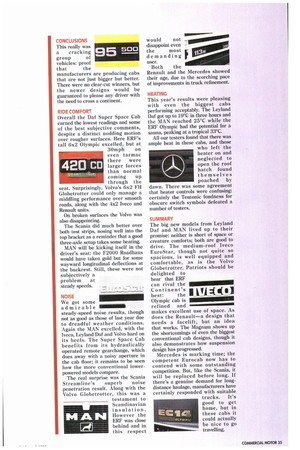CONCLUSIONS This really was a cracking group of vehicles: proof
Page 37

If you've noticed an error in this article please click here to report it so we can fix it.
that the manufacturers are producing cabs that are not just bigger but better. There were no clear-cut winners, but the newer designs would be guaranteed to please any driver with the need to cross a continent.
RIDE COMFORT Overall the Daf Super Space Cab earned the lowest readings and some of the best subjective comments, despite a distinct nodding motion over rougher surfaces. Here ERF's tall 6x2 Olympic excelled, but at 30mph on even tarmac there were larger forces than normal coming up through the seat. Surprisingly, Volvo's 6x2 FH Globetrotter could only manage a middling performance over smooth roads, along with the 4x2 Iveco and Renault units.
On broken surfaces the Volvo was also disappointing.
The Scania did much better over both test strips, nosing well into the top bracket as a reminder that a good three-axle setup takes some beating.
MAN will be kicking itself in the driver's seat: the F2000 Roadhaus would have taken gold but for some wayward longitudinal deflections at the backrest. Still, these were not subjectively a problem at steady speeds. 420 CD
IGF
NOISE We got some admirable steady-speed noise results, though not as good as those of last year due to dreadful weather conditions. Again the MAN excelled, with the Iveco, Leyland Daf and Volvo hard on its heels. The Super Space Cab benefits from its hydraulically operated remote gearchange, which does away with a noisy aperture in the cab floor; it remains to be seen how the more conventional lower. poweredmodels compare.
The real surprise was the Scania Streamline's superb noise penetration result. Along with the Volvo Globetrotter, this was a testament to Scandinavian insulation. However the ERF was close behind and in this respect
1111111•11111MIli
would not _im.0111111111111111111 disappoint even - the most F demanding user.
Both the Renault and the Mercedes showed their age, due to the scorching pace of improvements in truck refinement.
HEATING This year's results were pleasing with even the biggest cabs performing acceptably. The Leyland Daf got up to 19°C in three hours and the MAN reached 25°C while the ERF Olympic had the potential for a sauna, peaking at a tropical 33°C.
All our testers found that there was ample heat in these cabs, and those who left the heater on and neglected to open the roof hatch found themselves poached by dawn. There was some agreement that heater controls were confusing: certainly the Teutonic fondness for obscure switch symbols defeated a number of testers.
SUMMARY The big new models from Leyland Daf and MAN lived up to their promise: neither is short of space or creature comforts; both are good to drive. The medium-roof Iveco EuroStar, though not quite so spacious, is well equipped and comfortable, as is the Volvo Globetrotter. Patriots should be delighted to hear that ERF can rival the Continent's best: the Olympic cab is refined and makes excellent use of space. As does the Renault—a design that needs a facelift, but an idea that works. The Magnum shows up the shortcomings of even the biggest conventional cab designs, though it also demonstrates how suspension design has progressed.
Mercedes is marking time; the competent Eurocab now has to contend with some outstanding competition. But, like the Scania, it will be replaced before long. If there's a genuine demand for longdistance haulage, manufacturers have certainly responded with suitable trucks. It's good to get home, but in these cabs it could actually be nice to go travelling. 1_114 Kell
































































































